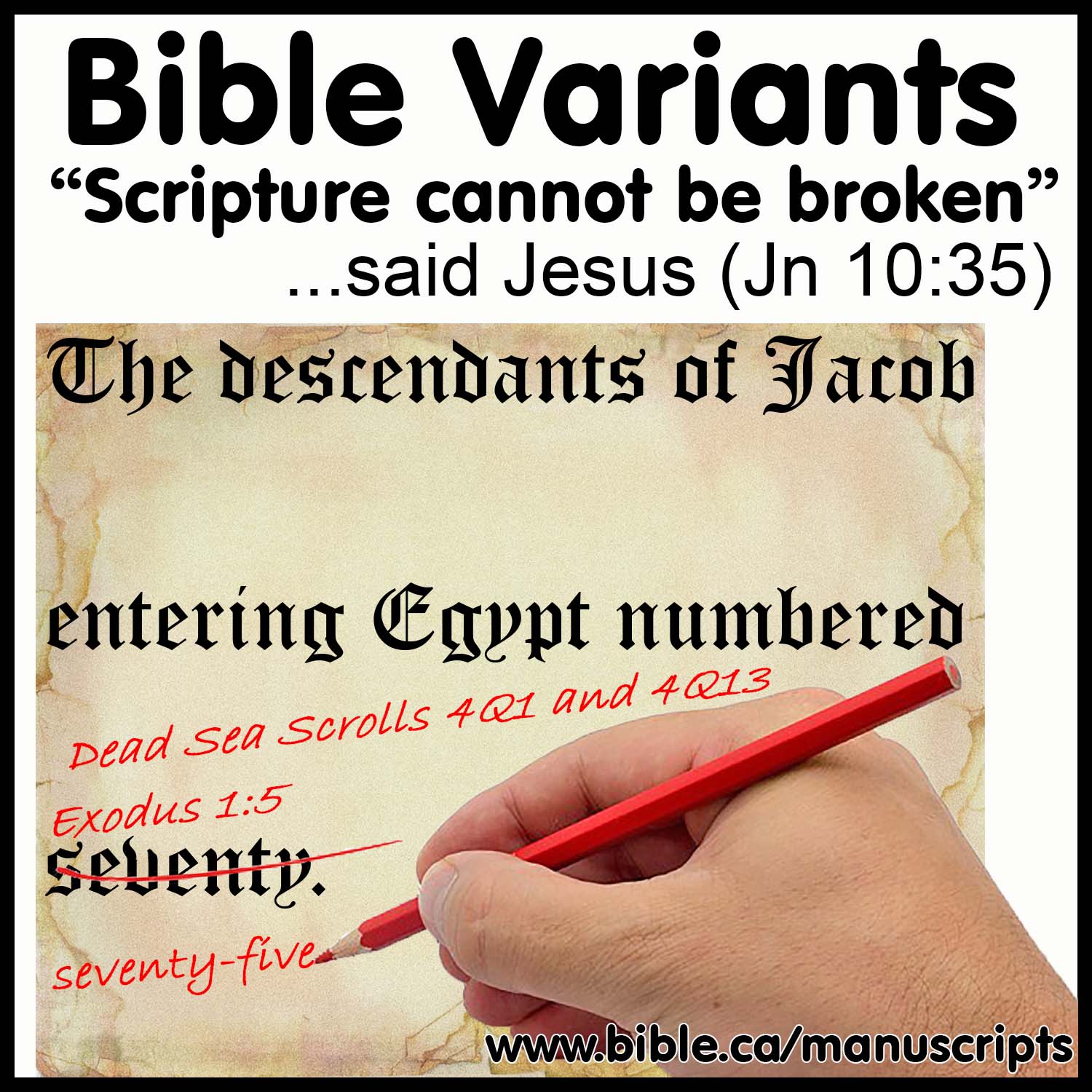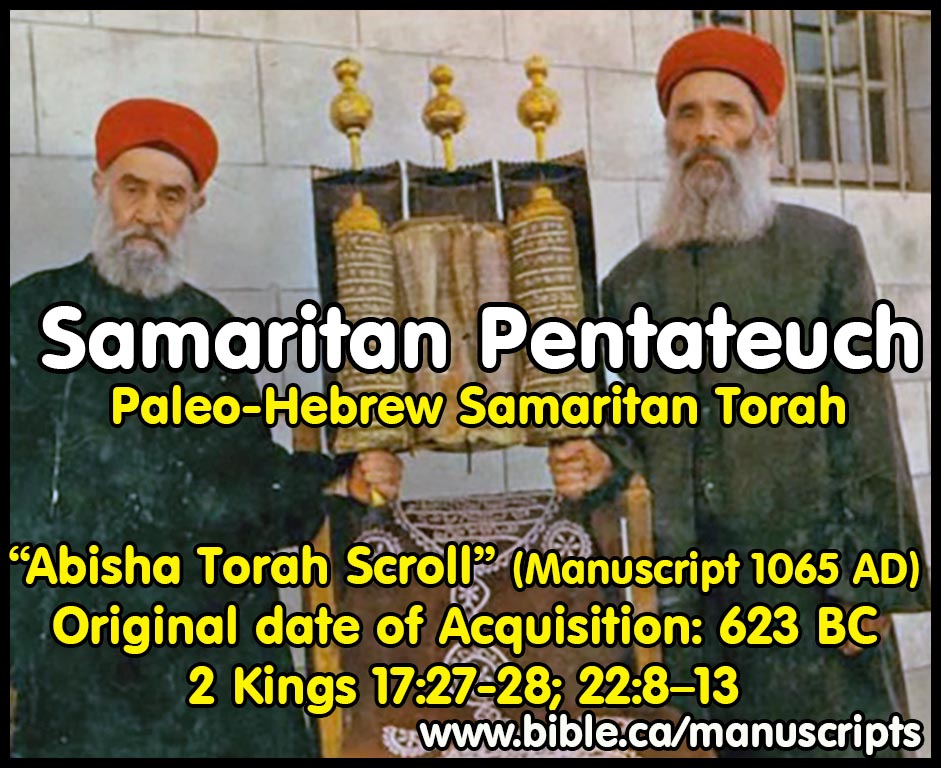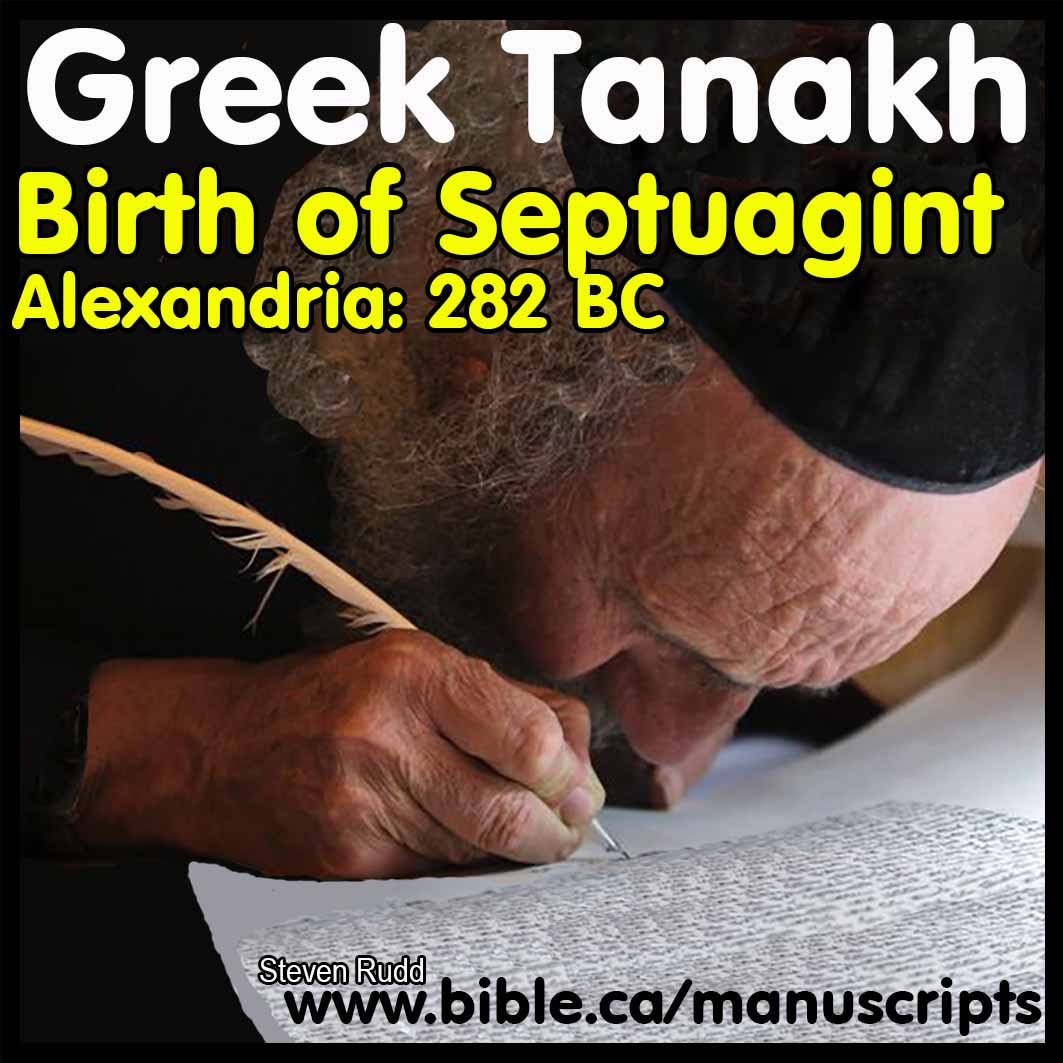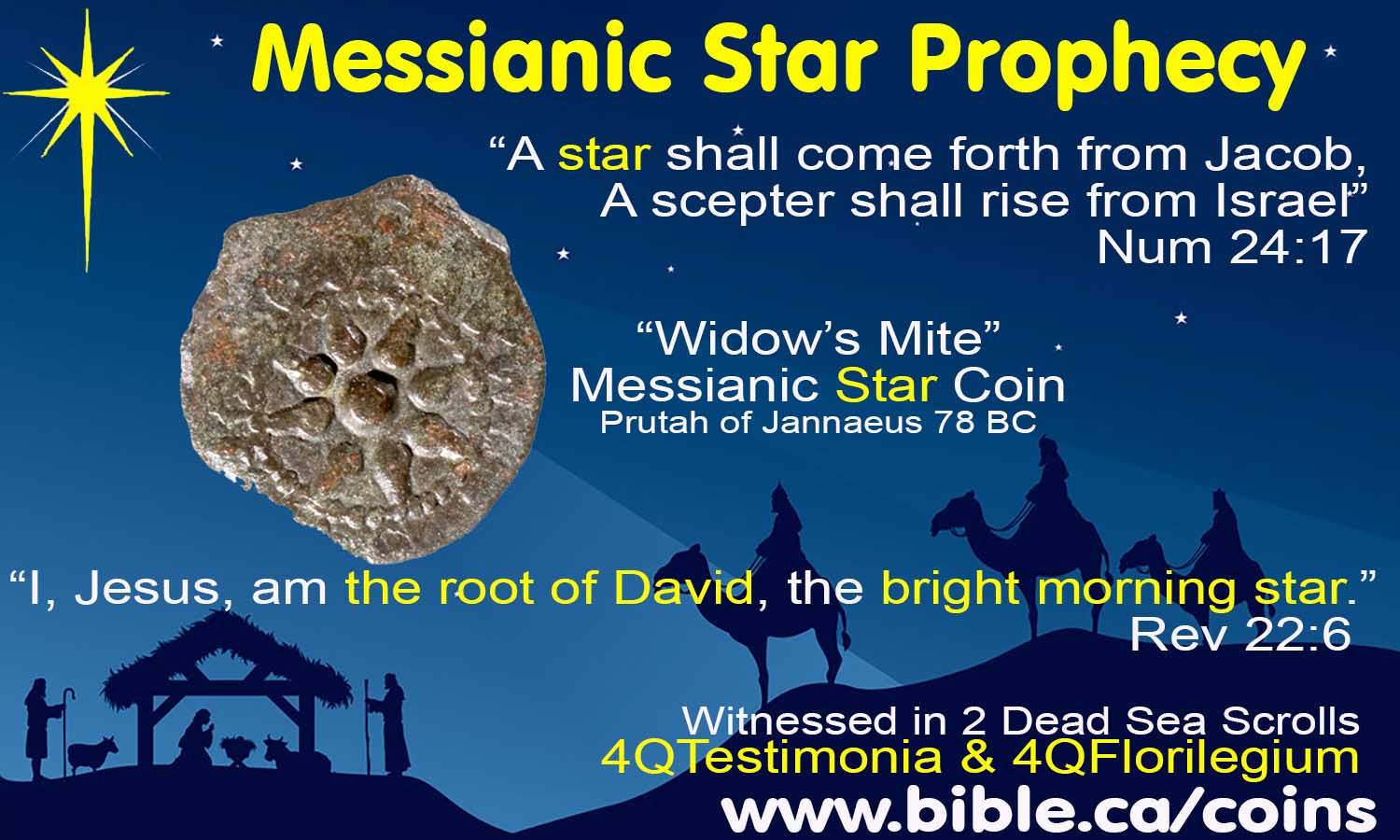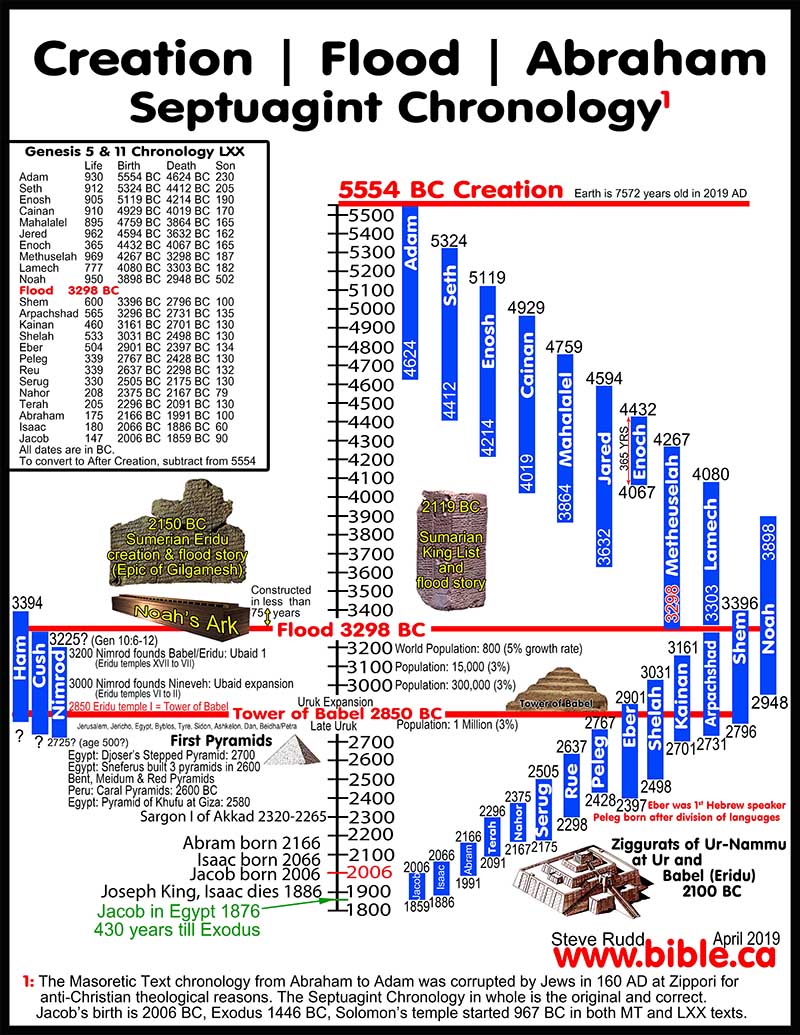|
Long vs. Short Egyptian sojourn: 430 years (Israel spent 430 years not 215 years in Egypt) Chronological Interpretation Variants in the Bible "Scripture cannot be broken" (Jesus, John 10:35) "My word will accomplish what I desire and succeed in the purpose for which I sent it." (Isa 55:11) Steve Rudd November 2017 |
Long vs. Short Egyptian sojourn: Israel spent 430 not 215 years in Egypt.
Chronological Interpretation Variants in the Bible
Bible textual variants analysed
Introduction:
Israel spent 430 years in Egypt. The theological variant interpretation about the long vs. short sojourn of Israel in Egypt makes a 215-year difference in the age of the earth. Israel lived in Egypt 430 not 215 years. An insignificant gloss which dates to 282 BC, contains the addition of the words “and in Canaan” in the LXX and the Samaritan Pentateuch (SP). This gloss appears to be an attempt to harmonize a chronological puzzle between Levi and Moses, “four generations later” listed in Exodus 6:16-20. The original Jewish translators of the LXX in 282 BC attempted to fix what they thought was a problem. In doing so, they created a domino effect of confusion that was resolved once and for all in the New Testament by Stephen in Acts 7:6 and Paul in Acts 13:19, certifying the long sojourn of 430 years as the correct reading. The Masoretic text preserved the correct reading and the Jewish Septuagint translators in 282 BC were wrong in changing the text.
I. Exodus 12:40: Israel was in Egypt 430 years: Long sojourn
1. New Testament absolutely validates the long sojourn:
a. In Acts 7:6 Stephen assigned 400 years specifically to being “aliens” and suffering slavery and oppression inside Egypt EXCLUDING Abraham and Isaac. Abraham’s descendants would be aliens in a foreign land” excludes Abraham from the equation.
b. In Acts 13:19 Paul assigned “about 450 years” from the time Jacob entered Egypt in 1876 BC to when Joshua parceled out the land to the tribes in 1399 BC. The actual number of years is 477 [1876 – 1399] but Paul was using a general number.
c. In Gal 3:16-17, Paul said that 430 years would pass after the promises were spoken to Abraham. But this promise had also been made to Isaac and Jacob. In other worlds, the time clock didn’t start ticking until they entered Egypt. The 430 years began with Jacob entering Egypt.
d. In 1876 BC, the very year Jacob moved to Egypt, God repeated the PROMISES "So Israel set out with all that he had, and came to Beersheba, and offered sacrifices to the God of his father Isaac. God spoke to Israel in visions of the night and said, “Jacob, Jacob.” And he said, “Here I am.” He said, “I am God, the God of your father; do not be afraid to go down to Egypt, for I will make you a great nation there. “I will go down with you to Egypt, and I will also surely bring you up again; and Joseph will close your eyes.”" (Genesis 46:1–4)
2. Important chronological facts:
a. It is exactly 215 years from the time Abraham left Haran (2091 BC) and the time Jacob entered Egypt (1876 BC): 2091-1876 = 215. This is exactly half of 430. There is no apparent importance of this detail.
b. It is exactly 430 years from the time Jacob entered Egypt (1876 BC) to the time of the Exodus (1446 BC): 1876-1446 = 430. But this date is a consequence of the long sojourn assumption of adding 430 years to 1446 BC.
c. Therefore, while we can be certain that the 215 years is a solid and independent number, the 430 number provides no support for the long sojourn.
3. The debate over how long Israel spent in Egypt is an ancient discussion which has direct impact on Bible chronology before the Exodus.
a. It is likely that the original reading was “in Egypt” and the phrase “and in Canaan” is a gloss AND that this gloss must have predated the LXX translation in 282 BC.
b. This means that either the Hebrew text from which the Septuagint was translated already had the gloss or that the translators in 282 BC invented the gloss themselves.
c. This is a puzzle because the translators were Jerusalem approved scholars. Perhaps this had already been a point of discussion for some time prior to 282 BC.
d. What this shows us is that this is a real problem that the ancients noticed.
e. Only through the New Testament can the matter be settled with certainty that the time in Egypt was a full 430 years.
4. While we have solid chronological data up to the destruction of Shiloh in 1094 BC, the date of the Exodus is determined by the 480 years from the 4th year of Solomon in 967 BC.
a. The date for the birth of Jacob in 2006 BC is considered a cornerstone of the Patriarchal chronologies, yet this date is calculated by taking the dates of the Exodus in 1446 BC, adding 430 years to the time Jacob entered Egypt in 1876 BC at age 130. (1446 + 430 + 130 = 2006 BC)
b. So we have no independent error checker or alternative method of dating the birth of Jacob in 2006 BC to prove the long sojourn. So the date of Jacob’s birth is directly dependant upon how we define the 430 years.
c. It may or may not mean anything that half of 430 =215 years, which is the exact number you get from the time Abraham left Haran in 2091 BC to the time Jacob entered Egypt in 1876 BC (2091-1876 = 215).
d. This calculation is the same for both long and short sojourns because the numbers are an independent time chunk.
II. The historical origin of the fictional 215-year short sojourn in Egypt:
1. The perceived problem the scribes sought to fix was the calculation of years from Jacob to Moses which appeared to contradict the 430 year long sojourn, so they searched for a fix.
a. In the end they made matters worse, not better.
b. They also went from truth to error by embracing the short sojourn of 215 years.
c. What got them started down the road, was that from Abraham leaving Haran to Jacob entering Egypt was 215 years which was exactly half of 430 years.
d. This is how they came up with the false idea that the 430 years dated from Abraham to the Exodus.
2. PROBLEM #1: “Forth generation”: Gen 15:16
a. Abraham was just told three verses earlier in Gen 15:13 that the slavery would last 400 years.
b. Abraham had Isaac when he was 100 years old. The most natural reading is that four generations, as Abraham himself would have viewed it, was 400 years. In other words, Abraham viewed 4 generations not as the time it took to for his great, great grandson to be born, but as four periods of 100 years. The 400 years = 4 generations both of which correspond to slavery and oppression in Egypt.
c. In addition to viewing a generation as a simple 100-year period, this matches the 4 generations listed in Gen 46:8-11 of those who entered and exited Egypt: Levi | Kohath | Amram | Moses. There is no reason to reject that this lineage is four 100-year, father to son periods. Moses lived to be 120 and Joshua 110 years old.
d. The four generations in the Levi to Moses lineage correspond to 11 generations in Joseph’s line: 1 Chron. 7:22–27.
e. Compare this to the 366-year period for five generations in David’s lineage: Salmon/Rahab | Boaz/Ruth |Obed | Jesse | David. Rahab the harlot married Salmon in 1406 BC who became the parents of Boaz who married Ruth in 1284 BC. That is a 122-year period between the marriages in a single generation (Rahab to Salmon). Ruth was the great, great grandmother of David who was born in 1040 BC which is 244 years for four generations.
f. The three periods of 14 generations in Matthew 1:17 are a total time span of 2164 years between Abraham/2166 BC | David/1040 BC | Babylonian captivity/587 BC | Jesus/2 BC. It is 1126 years for 14 generations between Abraham to David, 453 years between David and the captivity, 585 year between the captivity and Jesus. The first period of 14 generations is twice as long as the last two. This is consistent with the longer life spans that often exceeded 100 years at the time of the Exodus.
g. There were 10 generations living in Egypt in 1 Chronicles 7:20-21: Jacob | Joseph | Ephraim | Shuthelah | Bered | Tahath | Eleadah | Tahath | Zabad | Shuthelah.
h. There were 12 generations living in Egypt in 1 Chronicles 7:20-27: Jacob | Joseph | Ephraim | Shuthelah | Bered | Resheph | Telah | Tahan | Ladan | Ammihud | Elishama |Non/Nun | Joshua
i. What we learn from all this, is that the birth of Abraham’s son at age 100 was more a consistent pattern rather than a one time exceptional case. This may show God’s miraculous activity throughout the messianic bloodline.
j. While the entire world (including the Hebrews) became slaves to Pharaoh at the end of the 7th year of famine, their oppression did not begin until the rise of the first 18th dynasty pharaoh Ahmoses I in 1557 BC. Initially under Joseph, the Hebrews were exempt from land confiscation and were given a free food allowance no one else was given. They also lived at the end of the major ancient shipping lane called the “way of Horis” which terminated at Avaris (Tel el Dab’a). At the end of the 7 year famine, the Israelites were rich and were in control of a major shipping port. It was this prosperity that concerned the 18th dynasty pharaoh’s, not that they would overthrow the government, but leave!
3. PROBLEM #2: 430-year Long Sojourn calculation of Moses’ ancestry: Jacob | Levi | Kohath | Amram | Moses
a. Jacob married Rachel and Leah in 1923 BC, seven years after fleeing Esau to Laban in 1930 BC.
b. Levi born around 1920 BC being the third son of Jacob and Leah, born before Jacob fled from Laban and returned to Canaan in 1910 BC. Leah bore four sons then the Lord closed her womb for a time. So Levi would have been born around year 5 of the marriage when Jacob was 86 years old. Levi was 44 years old when he entered Egypt and died at age 137 in 1783 BC.
c. “I Levi was conceived in Haran and born there, and after that I came with my father to Shechem. And I was young, about twenty years of age, when with Simeon I wrought the vengeance on Hamor for our sister Dinah.” (Testament of the Twelve Patriarchs, Levi 2, cf. 4Q213 & 4Q214, 100 BC, but expanded by Christians around 192 AD, this quote likely dates to 100 BC)
d. Assume Kothath was born in 1877 BC: Kohath was second born son to Levi BEFORE Jacob entered Egypt in 1876 BC: “Now these are the names of the sons of Israel, Jacob and his sons, who went to Egypt: … The sons of Levi: Gershon, Kohath, and Merari." (Genesis 46:8,11). If Kohath was 1 year old when he entered Egypt in 1876 BC, Levi would have been 43 years old when Kohath was born. Kohath lived a total of 133 years and died in Egypt in 1744 BC.
e. Assume Amram was born in 1777 BC when his father Kohath was 100 years old. We have no idea when Amram was born but he lives 137 years so he died in 1640 BC.
f. Assume Moses was born to Amram when he was 100 years old in 1677.
g. According to both the Long and short sojourn, Moses was born in 1526 BC and was 80 years old in 1446 BC at the time of the Exodus.
h. The long sojourn has a discrepancy of 151 missing years between his calculated birth in 1640 BC and his actual birth in 1526 BC and this is with a 100 year range from father to son birth.
i. “The ancestry of Moses’ family in Exodus 6:16–20 is modestly abridged (just as Ezra, with similar humility, demonstrably abbreviates his own family line in Ezra 7:1–5, leaving out five known generations of his priestly forebears; cf. 1 Chron. 6:3–15). Confirming this is the fact that the Amramites by Moses’ time numbered some 4,300 people (averaged from Num. 3:19, 27–28), which in just two, or even three, generations is simply impossible. Indeed, the growth of Israel from 70 people to some two million, while consistent (at the high birth rates Scripture mentions in Ex.1:7) with the 430- year sojourn, would have required an astronomical doubling every fourteen years for a 215-year sojourn, without even taking into account the killing for a time of the male babies!” (Short sojourn comes up short?, Brenton Minge, Journal of Creation, 21/3, p63, 2007 AD)
j. “Moses shows, by reasonable inference, that the Amramites just after the Exodus numbered some 2,150 males. If this Amram was the same Amram as Moses’ father, this means that Moses must have had ‘2,147 brothers and brothers’ sons’, as Keil and Delitzsch point out. Such a proposition, of course, is absurd. Yet it is statistical conundrums like this that compel even a short-sojourn advocate like Nahum Sarna to concede that the population data ‘poses intractable problems’ for a two-century sojourn (emphasis added).” (215-year sojourn still short, Brenton Minge, Journal of Creation, 22/1, p58, 2008 AD)
k. Note: Demetrius says Levi was 43 years old but this is wrong because Levi was born before Jacob returned to Canaan: “17. And in the third year of the famine in Egypt, Jacob came into Egypt when he was 130 years old; Reuben, (44 years and 10 months); Simeon, 44 years; Levi, 43 years (and 2 months); Judah, 42 years, and (4) months; (Dan, 42 years and 4 months); Naphtali, 41 years and (6) months; Gad, 41 years and (6) months; Asher, 40 years and 8 months; (Issachar, 40 years and 8 months); Zebulun, (39 years and 10 months); Dinah, 39 years; and Benjamin, (22) years old. 18. But Joseph (he says) was already there in Egypt, (at age) 39; and from Adam until Joseph's brothers came into Egypt there were 3624 years; and from the deluge until Jacob's coming into Egypt, 1360 years; and from the time when Abraham was chosen from among the gentiles and came from Haran into Canaan until Jacob and his family came into Egypt there were 215 years.” (Demetrius the Chronographer, Jewish Historian, Fragment two, lines 17-8, 225 BC)
4. PROBLEM #3: 215-year Short Sojourn calculation of Moses’ ancestry: Jacob | Levi | Kohath | Amram | Moses
a. "These are the names of the sons of Levi according to their generations: Gershon and Kohath and Merari; and the length of Levi’s life was 137 years. ... The sons of Kohath: Amram and Izhar and Hebron and Uzziel; and the length of Kohath’s life was 133 years. … Amram married his father’s sister Jochebed, and she bore him Aaron and Moses; and the length of Amram’s life was 137 years." (Exodus 6:16-20)
b. The short sojourn also has an exodus of 1446 BC and Moses born in 1526 BC which calculates Jacob entering Egypt in 1661 BC.
c. The short sojourn calculates 135 years from Moses’ birth in 1526 BC back to Jacob entering Egypt in 1661 BC. In these 135 years we need to merely fit in two generations of fathers and sons. This is an easy fit if we assume each descendant was born when the father was around 67 years old (135 /2= 67.5). Kohath was 67 years old in 1593 BC when his son Amram was born. Amram was 67 years old in 1526 BC when Moses was born. But this means that Moses’ grandfather Kohath lived a total of 133 years and died in Egypt in 1528 BC, 2 years before Moses was born. It also means that Moses’ father died in 1456 BC or exactly 10 years before the exodus.
d. Jacob married Rachel and Leah in 1708 BC, seven years after fleeing Esau to Laban in 1715 BC.
e. Levi was born around 1705 BC being the third son of Jacob and Leah, born before Jacob fled from Laban and returned to Canaan in 1695 BC. Leah bore four sons then the Lord closed her womb for a time. So Levi would have been born around year 5 of the marriage when Jacob was 86 years old. Levi was 44 years old when he entered Egypt and died at age 137 in 1568 BC.
f. The short sojourn is a perfect fit to the chronological numbers of Moses back to Jacob.
g. The short sojourn also is a perfect fit for the Hyksos who arrived in 1657 BC, 100 years before the rise of the 18th dynasty pharaoh’s by Ahmoses I in 1556 BC. Jacob enters Egypt in 1661 BC and 4 years later we have the Hyksos in 1657 BC. This would make the Hyksos into Joseph and the Hebrews as opposed to “mysterious unknown Semite kings”. The dates are so close, they are within 4 years.
h. The problem is that the 215 year short sojourn makes the Hebrews themselves into the Hyksos.
5. PROBLEM #4: Population dynamics are a problem for the short sojourn:
a. From Abraham to Jacob: 2 – 70 in 215 years.
b. From Jacob to Moses: 70 – 3.5 million in 215 years vs 430 years.
c. For those who wrongly take the Hebrew word for thousands “elep” to simply mean clans and have an exodus population of 5-35,000 Hebrews, the short sojourn fits perfect but it guts the inspiration of the Bible. Even Joseph said there were 600,000 men of war in 1446 BC. “Now the entire multitude of those that went out, including the women and children, was not easy to be numbered; but those that were of an age fit for war, were six hundred thousand.” (Josephus Antiquities 2.317)
d. See full outline on population of the Exodus Jews was 3.5 million.
III. The Variant of 282 BC: The Scribal fix that created even more confusion:
1. The Septuagint is the origin of all the variants in manuscripts after 282 BC:
a. “The Hebrew text underlying the LXX almost certainly represents the original spurious variant because the reading in the LXX, which places Egypt before Canaan, can explain the rise of the reading in the Samaritan Pentateuch. Conversely, the reading in the Samaritan Pentateuch, which places Canaan before Egypt, cannot explain the rise of the variant in the LXX. After all, the chronological order of the locations where the Israelites resided was Canaan first, then Egypt. A scribe who saw in his exemplar that his forefathers resided in Canaan (first) and (then) in Egypt would not "fix" the text by altering the wording to state that they resided in Egypt (first) and (then) in Canaan. However, if a scribe saw in his exemplar that they resided in Egypt (first) and (then) in Canaan, which is the opposite of chronological order, he definitely would be prone to fix the perceived chronological error in his exemplar. For this reason, Propp referred to the Samaritan Pentateuch's reading as more logical than the LXX's reading. Moreover, the presence of "and their fathers" after "the sons of Israel" in the Samaritan Pentateuch must have been added to alleviate the problem that the sojourns of Abraham and Isaac in Canaan were excluded from the sojourn of Exodus 12:40 in the LXX, given that these patriarchs predated the sons of Israel. Therefore, the reading in the LXX almost certainly led to the reading in the Samaritan Pentateuch. This progression points instructively to the most important canon of textual criticism: prefer the reading that best explains the rise of the other readings, as the reading from which the origin of the other readings most easily can be explained is most likely to be original. Black referred to this as the basic principle of internal evidence.” (Determining the precise length of the Israelite Sojourn in Egypt, Douglas Petrovich, NEAS Bulletin, p27, 2019 AD)
2. Variant Bible verses:
a. "Now the time that the sons of Israel lived in Egypt was four hundred and thirty years. And at the end of four hundred and thirty years, to the very day, all the hosts of the Lord went out from the land of Egypt." (Exodus 12:40–41, MT)
b. "Now the sojourn of the children of Israel, during which they dwelt in the land of Egypt and in the land of Canaan, was four hundred and thirty-five years. And it happened that after the four hundred and thirty-five years, all the hosts of the Lord went forth from the land of Egypt by night." (Exodus 12:40–41, LXX)
c. “Now the residing of the sons of Israel and their fathers during which they resided in the land of Canaan and in the land of Egypt was 430 years.” (Ex 12:40, Samaritan Pentateuch “SP”)
3. Other relevant Bible verses:
a. "God said to Abram, “Know for certain that your descendants will be strangers in a land that is not theirs, where they will be enslaved and oppressed four hundred years. “But I will also judge the nation whom they will serve, and afterward they will come out with many possessions. “As for you, you shall go to your fathers in peace; you will be buried at a good old age. “Then in the fourth generation they will return here, for the iniquity of the Amorite is not yet complete.”" (Genesis 15:13–16)
b. "God said to Abram, “Know for certain that your descendants will be strangers in a land that is not theirs, where they will be enslaved and oppressed four hundred years." (Genesis 15:13)
c. "“But God spoke to this effect, that his descendants would be aliens in a foreign land, and that they would be enslaved and mistreated for four hundred years." (Acts 7:6)
d. "“The God of this people Israel chose our fathers and made the people great during their stay in the land of Egypt, and with an uplifted arm He led them out from it. “For a period of about forty years He put up with them in the wilderness. “When He had destroyed seven nations in the land of Canaan, He distributed their land as an inheritance—all of which took about four hundred and fifty years. “After these things He gave them judges until Samuel the prophet." (Acts 13:17–20)
e. “And at the end of four hundred and thirty years, to the very day, all the hosts of the Lord went out from the land of Egypt." (Exodus 12:40–41)
f. "“Then in the fourth generation they will return here, for the iniquity of the Amorite is not yet complete.”" (Genesis 15:16)
g. "What I am saying is this: the Law, which came four hundred and thirty years later, does not invalidate a covenant previously ratified by God, so as to nullify the promise." (Galatians 3:17)
h. "These are the names of the sons of Levi according to their generations: Gershon and Kohath and Merari; and the length of Levi’s life was 137 years. ... The sons of Kohath: Amram and Izhar and Hebron and Uzziel; and the length of Kohath’s life was 133 years. … Amram married his father’s sister Jochebed, and she bore him Aaron and Moses; and the length of Amram’s life was 137 years." (Exodus 6:16-20)
4. Archeological Manuscript details of Ex 12:40
a. The Masoretic Text reads: “In Egypt”
b. Reversed word order: LXX vs. Samaritan Pentateuch (SP). The LXX has “in Egypt and in the land of Canaan” but the Samaritan Pentateuch has “in Canaan and in the land of Egypt”.
c. The Hebrew Samaritan Pentateuch is alone in adding “and their fathers”.
d. Codex Vaticanus LXX reads “435 years”
e. Codex Alexandrinus LXX reads “for them and their fathers during which they dwelled in the land of Egypt and in the land of Canaan” indicating that time in Canaan was during the conquest of Joshua after 1406 BC.
f. Dead Sea scrolls: 4Q14 Exodusc (Col. V Fragments 32i Col. i, Exodus 12:31–48) agrees with the Masoretic but adds “the land of”: “Now the residing of the sons of Israel during which they resided in the land of Egypt was 430 years.”
g. The Vulgate, which Jerome translated from Hebrew into Latin, supports the 430 year long sojourn.
h. The Peshitta translation from Hebrew into Syriac supports the 430 year long sojourn.
5. Masoretic (MT) and Dead Sea scroll 4Q14 both support the long sojourn with only three words difference: “the land of”
a. “Now the residing of the sons of Israel during which they resided in Egypt was 430 years.” (Ex 12:40, MT)
b. “Now the residing of the sons of Israel during which they resided in the land of Egypt was 430 years.” (Ex 12:40. 4Q14 Exodusc)
IV. Josephus contradicts himself and supports both long and short sojourn:
1. Josephus must have been aware that there were two views:
2. 215 years in Egypt:
a. “They left Egypt in the month of Xanthicus, on the fifteenth day of the lunar month; 430 years after our forefather Abraham came into Canaan, but 215 years only after Jacob removed into Egypt.” (Josephus Antiquities 2.318)
3. 400 years in Egypt:
a. “And four hundred years did they spend under these afflictions; for they strove one against the other which should get the mastery, the Egyptians desiring to destroy the Israelites by these labors, and the Israelites desiring to hold out to the end under them.” (Josephus Antiquities 2.204)
IV. Demetrius the Chronographer used 430 years for sojourn in 225 BC
1. Demetrius the Chronographer used the long sojourn of 430 years.
2. “from Adam until Joseph's brothers came into Egypt there were 3624 years; and from the deluge until Jacob's coming into Egypt, 1360 years” (Demetrius the Chronographer, Jewish historian, Fragment two, lines 17-8, 225 BC)
V. The Samaritans used the 215 year sojourn but the ancient Jews 430:
1. “The first exile of the people of Israel was not in Babylon, nor Madai, nor Assyria, but in Egypt after Jacob and his successors went down there to live with Joseph in the period of exile that lasted 215 years according to the Samaritans and 430 years according to the Jews.” (The Israelite Samaritan version of the Torah: First English translation compared with the Masoretic version, Benyamim Tsedaka, Sharon Sullivan, The First English Translation of the Israelite Samaritan Torah, Benyamim Tsedaka, p xxviii, 2013 AD)
VI. Jews today use the 215-year sojourn:
- "Now the Time that the Children of Israel Dwelt in Egypt [and in the Land of Canaan and in the Land of Goshen] (added into LXX for Ptolemy) Was Four Hundred and Thirty Years. This is one of the passages which they changed when writing the Torah for king Ptolemy. Likewise they wrote for him: “God created in the beginning” (Gen. 1:1, Comp. Geiger, Urschrift, p. 439 ff.); “I will make a man according to an image and a likeness” (Gen 1:26); “A male with corresponding female parts created He him” (Gen 5:2); “And God finished on the sixth day … and rested on the seventh day” (Gen 2:2); “Now I will go down and there confound their language” (Gen 11:7); “And Sarah laughed among her relatives” (Gen 18:12); “For in their anger they slew an ox and in their self will they tore up a stall” (Gen 49:6); “And Moses took his wife and his sons and set them upon a carrier of man” (Ex. 4:20); “I have not taken any desirable thing from them” (Num. 16:15); “Which the Lord thy God hath allotted to give light unto all the peoples” (Deut. 4:19); “Which I have commanded the nations not to worship them” (Deut 17:3); “And the slender-footed” (Lev. 11:6). And so also they wrote for him: “Now the time that the children of Israel dwelt in Egypt and in the land of Canaan and in the land of Goshen was four hundred and thirty years.” (Midrash: Mekilta de-Rabbi Ishmael, J. Z. Lauterbach, Jewish Publication Society, Tractate Pisḥa, Exodus 12:37-42, 2004 AD)
Conclusion:
1. New Testament absolutely validates the long sojourn for Israel in Egypt of 430 years:
a. Stephen assigned 400 years specifically to being “aliens” and suffering slavery and oppression inside Egypt EXCLUDING Abraham and Isaac in Acts 7:6. Abraham’s descendants would be aliens in a foreign land” excludes Abraham from the equation.
b. Paul assigned “about 450 years” from the time Jacob entered Egypt in 1876 BC to when Joshua parceled out the land to the tribes in 1399 BC In Acts 13:19. The actual number of years is 477 [1876 – 1399] but Paul was using a general number.
2. Demetrius the Chronographer used 430 years for sojourn in 225 BC.
3. The long sojourn of 430 years in Egypt and the original text of “in Egypt” Ex 12:40 is clearly the superior option.
a. The Dead sea scroll “4Q14 Exodusc” is a powerful evidence that confirms the reading in the Masoretic Text.
b. The New testament confirms the duration in Egypt was a full 430 years.
4. The evidence leads to the conclusion that there were two Hebrew manuscripts extant in the first century:
a. We have several examples of dual manuscript:
i. The longer and shorter Hebrew Dead Sea scrolls of Jeremiah.
ii. The numbers 70 and 75 who entered Egypt are both found in ancient Hebrew manuscripts.
b. In the case of Ex 12:40 the evidence for two different Hebrew manuscripts is the fact that the Septuagint was translated in 282 BC and Josephus included the gloss. The original did not have “and Canaan” and a second that contained either the gloss or scribal notes that were used to translate the Septuagint.
5. This ancient gloss that predates 282 BC, was a solution to an ancient “perceived” problem in harmonizing the given dates of the lineage of Levi to Moses.
a. The scribal fix only added to the confusion and perpetuated a false doctrine of the short 215-year sojourn in Egypt.
b. With the long sojourn of 430 years, the father son begetting age is 175 years, which is older than any of them lived about 50 years!
c. The solution was not to reduce the time Israel spent in Egypt, but to accept that gaps exist in this genealogy.
6. The current Hebrew Masoretic text is superior to the Septuagint and preserves the autograph reading but the variant option already existed in 282 BC when the Jerusalem translators chose to follow a second extant Hebrew text that lay before them.
a. The Septuagint translators, like the KJV translators, had two different Hebrew Texts before them: One with “in Egypt” and one with “In Egypt and Canaan”.
b. The Septuagint translators were aware of problem of the genealogy numbers of Levi to Moses and made the mistake of choosing the gloss despite the fact it did solve the problem.
7. The theological variant interpretation about the long vs. short sojourn of Israel in Egypt makes a 215-year difference in the age of the earth.
In the final analysis, we can be certain that we possess the word of God!
This is what Jesus meant, when He said: "Scripture cannot be broken" (Jesus, John 10:35)
"My word will accomplish what I desire and succeed in the purpose for which I sent it." (Isa 55:11)
|
The Septuagint LXX “Scripture Cannot Be Broken” |
|||||
|
Start Here: Master Introduction and Index |
|||||
|
Six Bible Manuscripts |
|||||
|
1446 BC Sinai Text (ST) |
1050 BC Samuel’s Text (SNT) |
623 BC Samaritan (SP) |
458 BC Ezra’s Text (XIV) |
282 BC Septuagint (LXX) |
160 AD Masoretic (MT) |
|
Research Tools |
|||||
|
Steve Rudd, November 2017 AD: Contact the author for comments, input or corrections |
|||||
By Steve Rudd: November 2017: Contact the author for comments, input or corrections.
Go to: Main Bible Manuscripts Page
Go to: Main Ancient Synagogue Start Page
